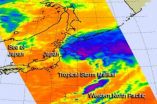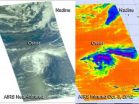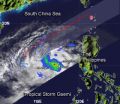(Press-News.org) To believe that technologies once dreamed of in science fiction novels, television shows, and comic strips may one day be a reality, or that real-world technologies might make the fantastic devices of fiction obsolete, you'd need to be either an optimist…or a futurist in the Department of Homeland Security (DHS)'s Science and Technology Directorate (S&T).
To keep dreams grounded, S&T maintains a team of futurists in Arlington, Va., at the Homeland Security Studies & Analysis Institute (HSSAI). There, in the Resilience and Emergency Preparedness / Response Branch, analysts explore the art of the possible, helping DHS shape dreams into a lucid, viable vision. "Revolutionary ways of working are often invented because visionaries saw a need and a novel way to meet it," said Deputy Director Bob Tuohy, who is an admitted sci-fi enthusiast.
In 2011, S&T's First Responders Group and FEMA's National Preparedness Directorate turned to Tuohy's team for assistance in forecasting first responder needs. The result was Project Responder 3: Toward the First Responder of the Future (PR3). The third in a series, PR3 identified the capabilities most critically needed to ensure that responders could meet disasters swiftly, surely, and safely in three to five years. "Faced with difficult budget choices, it's vital that the Department get it right so researchers explore the most pressing problems and companies develop the most wished-for tools," said Patrick Spahn, director of S&T's Operations Analysis / FFRDC Management Branch.
While PRs 1 and 2 (2004 and 2008) viewed technologies as a goal, the new report imagines how technologies will become workaday tools that are easily carried and used. Going further, it singles out technologies that will be needed by responders in multiple disciplines—for example, by firefighters and medics, or by emergency managers and police. In this way, DHS and its partners can make the most of limited resources by solving several challenges at once.
Beyond today's fiscal constraints, state and local responders needed to envision a future when budgets may be more solvent. "They asked us to forget that, today, everyone's broke," recalls Tuohy, "and imagine a 'blue sky' scenario, where anything might be possible."
The researchers were also asked to remember that people, places, and industries were becoming ever-more connected and interdependent. How might these dependencies make energy, water, food, and cyberspace itself more vulnerable to attack?
PR3 wasn't the first time the Department gazed a full generation into the future. For FEMA's Strategic Foresight Initiative (2011), DHS futurists flashed-forward to 2026 to help emergency managers understand how their role would be redefined by changes in climate, technology, and society. Every four years, the U.S. Coast Guard conducts its Evergreen process. And the Defense Department, through DARPA, routinely looks far into the future. The HSSAI researchers pored over similar studies from government, academia, responder groups, and industry. It was time well-spent. "We used Evergreen as a model for mapping scenarios against potential capabilities," says Tuohy.
PR3's data came primarily from comments and priorities voiced in 2011 by four focus groups, each composed of law enforcement officers, firefighters, paramedics, and emergency managers. The responders discussed and debated how their jobs would be transformed by changes in the economy, technology, and society, as well as by future calamities rivaling 9/11 or Japan's 2011 nuclear meltdown. How would these changes alter the role of the responder as an individual, on a small team? In a vast network? During a typical day or an anything-but-typical disaster?
If you're versed in network crime dramas—or Star Trek—PR3's findings will bear a familiar ring. If you're not, brace yourself for future shock:
Start with Dick Tracy's 2-Way Wrist TV of 1964, fast-forward several decades, and you're on your way to envisioning the law enforcement officer / deputy of the future. In 2031, when an officer needs information, he'll have it, as swiftly and surely as the good guys on Criminal Minds and CSI.
In fact, our future cop will seem blessed with a sixth sense. Donning "augmented reality" eyeglasses or a wristphone, he'll be able to ID a shady character while approaching him, pick out (and zoom in on) a terrorist, and find a weapon before it finds its victims. Armed with assistive technologies like data visualization, the law enforcer will also be fighting new forms of cyber crime. Wirelessly "plugged in" to a homeland-security network, he'll spend less time responding to crime, and more time thwarting it.
Using telemedicine, the paramedic of the future will make tough calls and perform advanced procedures onsite, aided by expert systems and doctors watching from afar. Much as OnStar or Sirius can dial 9-1-1 when a car's airbags deploy, a victim's smartphone (or whatever might replace it) will summon an ambulance if its owner is unconscious. The ambulance can then arrive swiftly and safely, using a jammer that can mute loud music in nearby cars and turn a red light green. Reaching the victim, the paramedic relieves the good Samaritan who has been coached by her phone's virtual physician. As the paramedic's own phone downloads the patient's medical history, a tiny "tricorder" will read the patient's vitals and scan for injuries. It's all in a routine day.
But "routine" will not exist if a city is struck by an earthquake, a radiological ("dirty") bomb, or a chemical or biological weapon. The paramedic of the future will carry or wear a suite of sensors to detect victims, reveal which of them needs the most urgent care, and warn him if he can't reach them safely. Together with stationary sensors, these mobile sensors will feed an intelligent triage system that grows smarter with experience.
In the paramedic's "medical bag," you'll find artificial red blood cells, perhaps artificial blood itself. When disaster strikes, the paramedic will be aided by 3D tracking, a lightweight protective suit, and a long-lasting oxygen supply that's trim and lightweight. Victims won't weigh down our paramedic: He'll get a boost from a robotic cot, a stair-chair, or perhaps an "Iron Man lite" exoskeleton.
Lighter gear, sensors that warn when to clear out, and smoke-penetrating goggles ranked high on the wish list of responders envisioning the firefighter of the future.
Like tomorrow's paramedic, the future firefighter may rely on robots to do heavy lifting or scope out a hostile environment. But mostly, he'll rely on headgear that streams "situational awareness" from a symphony of sensors. Warnings, maps, and other vital data will be beamed to a firefighter's eyes and ears, keeping hands free as they guide him into a fire and back out before the ceiling caves, his oxygen empties, or his body succumbs to heat.
Software will help the emergency manager (EM) of the future make urgent decisions, undistracted by logistics. When a hurricane in Florida creates hundreds of calls for portable generators, fresh water, and food, an expert system will sort them out, sending supplies—public and private—where they'll do the most good. And after an earthquake, smart sensors will "phone in" injuries and damage; the results will be color-coded onto high-resolution maps.
The EM, the cop, the fireman, and the medic share a need for game-changers such as multithreat protective suits that are comfortable, light, and slim; intelligent avatars that understand the spoken word; universal translators to let them converse with nervous immigrants; and new learning tools to help them master the new technologies. And responders will need smarter ways to work, team, enlist savvy citizens, and do their jobs if technology fails.
If you think S&T's researchers reached these conclusions by taking notes and tallying votes, think again. Since focus groups are small, findings can be unreliable. To firm up their findings, the HSSAI researchers turned to a survey technique called the Q Methodology—an intensive exercise that revealed, in nuanced detail, how respondents felt about their various needs. Each responder studied a long list of needs, ranking each need's priority from +3 to -3. Then, the researchers used factor analysis—a technique for describing how dramatically correlations vary—to reveal clusters of like priorities farther down the responders' wish lists.
Through factor analysis, an also-ran technology—much like an also-ran talent-show contender—may emerge as an unlikely favorite. When voters merely vote for their favorite contender, the nerd will lose—the fallback of millions, the favorite of few. But when voters voice how strongly they feel about each contender, their new idol may turn out to be the improbable, unglamorous nerd.
Meanwhile, responder agencies must face greater challenges imposed by budgetary belt-tightening, fiscal shortfalls, out-of-reach costs, out-of-touch policies, and out-of-date procedures.
Perhaps the pop-culture accounts of responder technologies are part of that problem. "Everything people see on TV, they think we have," one first responder remarked, adding that this delusion complicates matters when responder agencies are appealing for funds. Talent-show viewers can vote with their phones, but responders must vote with their wallets. That's why S&T is appealing to private industry to provide affordable answers.
Some answers will raise legal or ethical questions. For example, will a paramedic be free to view a patient's entire medical history, or view only the parts that can help her save a life? If a surgeon in Scranton is guiding a paramedic in Pittsburgh, what happens if the link fails?
And how do you sue an avatar for malpractice? Before telemedicine makes its debut, responders will need to hear from experts in medical malpractice and privacy.
That's fine with Spahn, who noted, "Anytime you deploy a new technology, life gets in the way. That's one reason we look so far into the future."
"It's tough to make predictions, especially about the future," said the late Yogi Berra. Project Responder 3 marked the first time S&T tuned its crystal ball 20 years out. But it won't be the last. In 2014, the digital ink will dry on PR4. What new capabilities, and new challenges, might that report describe? It's a tough job, but someone's got to do it. And for DHS, HSSAI will do it right.
INFORMATION:
To learn how the Homeland Security Studies & Analysis Institute can help your agency turn technology planning into a viable vision, contact Pat Spahn at patrick.spahn@hq.dhs.gov.
Far, far beyond wrist radios
At Homeland Security's think tank, first responders imagine a high-tech future
2012-10-05
ELSE PRESS RELEASES FROM THIS DATE:
NASA sees Tropical Storm Maliksi put final touches on Japan
2012-10-05
Tropical Storm Maliksi is putting the final touches on Japan, that is, the edge of the storm was seen brushing the country's northern coast as it pulled away on NASA satellite imagery.
NASA's Aqua satellite passed over Tropical Storm Maliksi on Oct. 4 at 0329 UTC (11:29 p.m. EDT, Oct. 3, EDT) and the Atmospheric Infrared Sounder (AIRS) instrument captured an infrared image of the storm brushing the Tohoku and Hokkaido prefectures of northern Japan.
On Oct. 4, 2012 at 1500 UTC (11 a.m. EDT), the Joint Typhoon Warning Center issued their final advisory on Maliksi. At ...
NASA gets 2 infrared views of tropical storms Nadine, Oscar
2012-10-05
NASA's Aqua satellite provided two different infrared views of the two tropical storms swirling in the Atlantic Ocean. Oscar is battling wind shear that appears destined to tear it apart, while Nadine is merging with a cold front.
NASA's Aqua satellite passed over both Tropical Storm Nadine and Tropical Depression 15 (TD15) on Oct. 3 at 1553 UTC (11:53 a.m. EDT), before TD15 became Tropical Storm Oscar. While overhead, the Atmospheric Infrared Sounder (AIRS) instrument aboard Aqua captured two different images of both storms. One image was near infrared and almost visible ...
NASA sees Tropical Storm Gaemi's heaviest rainfall around center
2012-10-05
Some of the most powerful thunderstorms in a tropical cyclone surround the center of circulation, and NASA's TRMM satellite noticed that rainfall is heaviest in that area of Tropical Storm Gaemi.
When NASA's Tropical Rainfall Measuring Mission (TRMM) satellite passed over Tropical Storm Gaemi on Oct. 3 at 1241 UTC (8:41 a.m. EDT), the precipitation radar instrument detected light rainfall occurring over most of the storm. Moderate rain was falling at a rate between .78 to 1.57 inches/20 to 40 mm per hour and surrounded a small area of heavy rainfall circling tightly around ...
Freezing water droplets form sharp ice peaks
2012-10-05
Researchers at the University of Twente, in the Netherlands, placed water droplets on a plate chilled to -20 degrees Celsius and captured images as a freezing front traveled up the droplet. The photos are published in the American Institute of Physics' (AIP) journal Physics of Fluids. The approximately 4-millimeter diameter droplets took about 20 seconds to freeze. During the final stage of freezing, the ice drop developed a pointy tip, as can be seen in Figure 1d. The effect, which is not observed for most other liquids, arises because water expands as it freezes. The ...
IntuiTouch Technologies Announces Development of ChiroSpring Practice Management Software
2012-10-05
"ChiroSpring is unique in the chiropractic software industry because it combines the most advanced technology with a design that couldn't be easier to use," said Brian Albery, CEO of ChiroSpring. "Doctors want electronic chiropractic software that allows their practice to run at maximum efficiency, but is also easy and intuitive to operate. While other chiropractor software programs force you to choose between functionality and simplicity, ChiroSpring offers an unbeatable combination of both. The best chiropractic software should give doctors everything they ...
Dr. Aristotle Economou, Acclaimed Functional Medicine Practitioner and Author of Change The Way You Heal, to Provide Free Telecall on Accelerated Pain Relief
2012-10-05
Dr. Aristotle Economou will provide a no cost telecall for people who wish to speed up the healing process and spend their time engaging in activities they enjoy. Using over 20 years of experience in the field of Functional Medicine, Dr. Aristotle Economou will discuss techniques on how to actively support the healing process.
Intended for an audience of health- and healing-conscious men and women, Pain Relief at the Speed of Light will provide techniques on how to relieve pain, as well as how to avoid it. The free telecall will highlight recuperation methods in the ...
Zac Pac Australia
2012-10-05
Zacpac, an independently owned and family run Australian Packaging business again proves that they're not only the pioneers in Australian packaging solutionsbut also are the best in providing fast, quality services and their continued growth has resulted in an all-new factory being built to satisfy demand. The new 8000 square metrestructure takes the total factory operating space to 19,000 square metres.
After purchasing ten acres of land in Ingleburn in 1991 and building the company's first factory in 1994, Ed Zac's vision of expanding the family business, specialising ...
Mixed Media Art's Abandoned Art First Annual Fall Blitz 2012
2012-10-05
On October 31, 2012 you are invited to participate in Mixed Media Art on Facebook's First Annual Fall Abandoned Art Blitz. The Fall Blitz will be held in your own neighborhood and will ask you to abandon a piece of your own artwork by tying it to a tree and offering it as a gift to a stranger.
Your art project may be in any medium, style, or size that you choose, however it must bear one of the Abandoned Art Fall Blitz 2012 tags, and be labeled as a 'Free Gift of Artwork'. A loose 'theme' inspired by Emily Jane Bronte's poem 'Fall, leaves, fall' may include an interpretation ...
OpticsCentral is Now Shipping Australia Wide
2012-10-05
OpticsCentral has recently launched its brand new website in conjunction with launching a brand new retail showroom in the eastern suburbs of Melbourne. OpticsCentral designed this site based on the teams knowledge and experience on how their customers shopped for Binoculars and Telescopes.
"We aim to deliver the best customer service across Australia. Therefore, our customer support team is well trained and experienced at selling these products over the phone and thoroughly explaining the features and expectation of these products to our customers" Andrew ...
ISSA-LA Encourages Greater Cybercrime Awareness During National Cyber Security Awareness Month
2012-10-05
The Los Angeles Chapter of the Information Systems Security Association (ISSA-LA) is encouraging every person and business in Los Angeles to learn how to better protect themselves from cybercrime during National Cyber Security Awareness Month. ISSA-LA's motto is It takes the village to secure the village SM, meaning everyone is aware, involved and taking personal responsibility for protecting information.
"Cybercrime and identity theft threaten our businesses, non-profits, government agencies, schools and even individual consumers," said Stan Stahl, Ph.D., ...
LAST 30 PRESS RELEASES:
Preoperative radiation may improve antitumor immune response in most common form of breast cancer
Breast MRI may be safely omitted from diagnostic workup in certain patients with early-stage, HR-negative breast cancer
Sentinel lymph node biopsy may be safely omitted in some patients with early-stage breast cancer
Rats may seek cannabis to cope with stress
New FAU research strengthens evidence linking alcohol use to cancer
Gut health à la CAR T
Dr. Pengfei Liu receives 2026 O'Donnell Award in Medicine for pioneering advances in genetic diagnostics and rare disease treatment
Dr. Yunsun Nam receives 2026 O'Donnell Award in Biological Sciences for pioneering RNA research transforming gene regulation and cancer therapy
Dr. Bilal Akin wins 2026 O'Donnell Award in Engineering for transformative work in EV energy systems and industrial automation
Dr. Fan Zhang receives 2026 O'Donnell Award in Physical Sciences for groundbreaking discoveries in quantum matter and topological physics
Dr. Yue Hu receives 2026 O'Donnell Award for revolutionizing energy operations with real-time AI and reinforcement learning
Greater risk that the political right falls for conspiracy theories
JMC Publication: Insilico’s AI platforms enable discovery of potent, selective, oral DGKα inhibitor to overcome checkpoint resistance
Targeting collagen signaling boosts drug delivery in pancreatic cancer
Valvular heart disease is common in cancer patients but interventions improve survival
When socially responsible investing backfires
Cuffless blood pressure technologies in wearable devices show promise to transform care
AI-based tool predicts future cardiovascular events in patients with angina
Researchers map how the cerebellum builds its connections with the rest of the brain during early development
Routine scans could detect early prostate radiotherapy changes
Fairness in AI: Study shows central role of human decision-making
Pandemic ‘beneath the surface’ has been quietly wiping out sea urchins around the world
Tea linked to stronger bones in older women, while coffee may pose risks
School feeding programs lead to modest but meaningful results
Researchers develop AI Tool to identify undiagnosed Alzheimer's cases while reducing disparities
Seaweed based carbon catalyst offers metal free solution for removing antibiotics from water
Simple organic additive supercharges UV treatment of “forever chemical” PFOA
£13m NHS bill for ‘mismanagement’ of menstrual bleeds
The Lancet Psychiatry: Slow tapering plus therapy most effective strategy for stopping antidepressants, finds major meta-analysis
Body image issues in adolescence linked to depression in adulthood
[Press-News.org] Far, far beyond wrist radiosAt Homeland Security's think tank, first responders imagine a high-tech future




